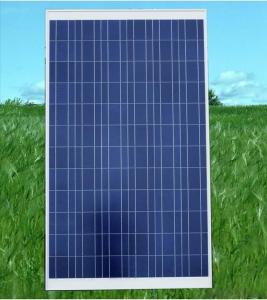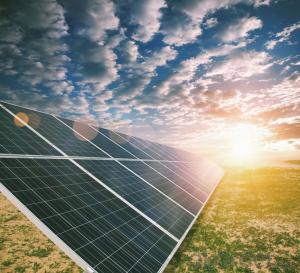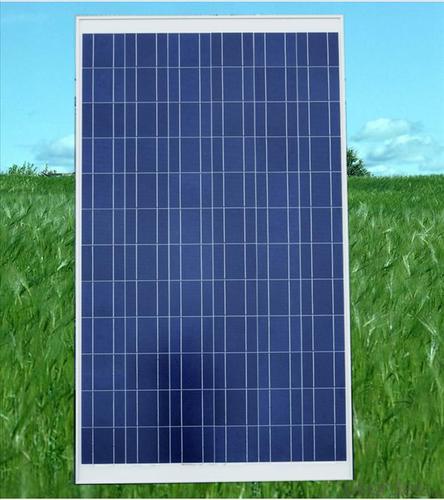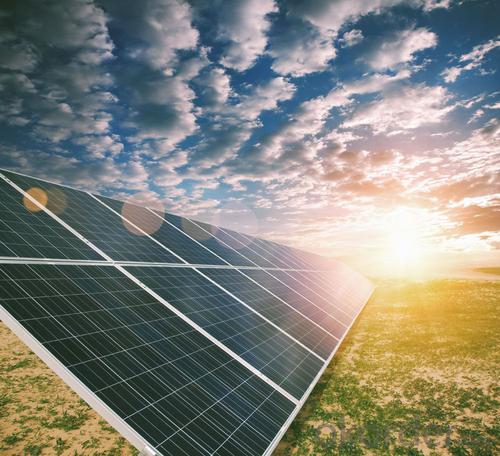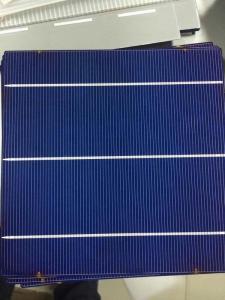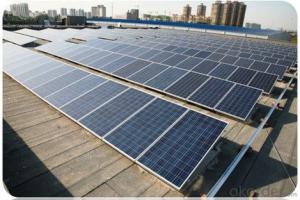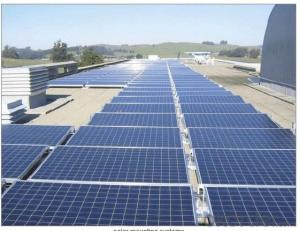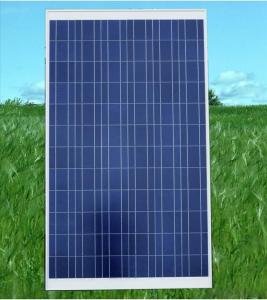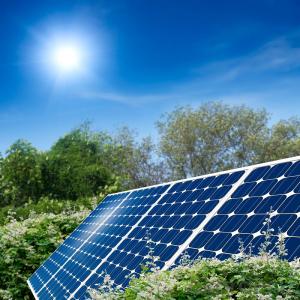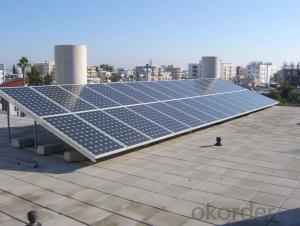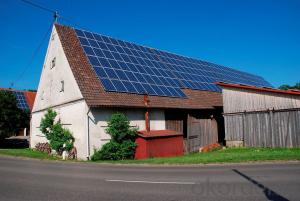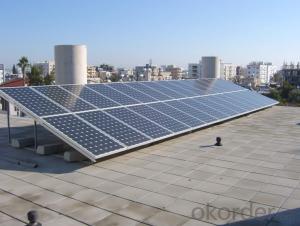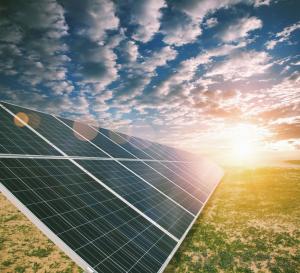305W Polycrystalline Silicon Solar Panels with Battery
- Loading Port:
- Guangzhou
- Payment Terms:
- TT OR LC
- Min Order Qty:
- 200000 watt
- Supply Capability:
- 20000000 watt/month
OKorder Service Pledge
OKorder Financial Service
You Might Also Like
About us
We are a high-tech group wich specializes in solar products design,research, manufacture, sales,solar projects design and installation.
Our national sales service covers seven parts, including northeast, north, east, middle, south, northwest and southwest, international sales covers five continents and over forty countries, including Germany, Italy, Spain, France, America and Brazil etc.
Our present annual capacity is 6 million for wafer, 60MWp for solar cells,200MWp for solar modules and one hundred thousand for solar applications. It is expected that the annual capacity of 2012 will be up to 30 million for wafer, 300MWp for solar cells, 1000MW for solar modules and 2 million for solar applications.
INTRODUCTION
This installation Manual contains essential information for the electrical and mechanical installation that your must know before installing CUSTOMER PV modules. This also contains safety information you need to be familiar with .All the information described in this manual are the intellectual property of CNBM and based on the technologies and experiences that have been acquired and accumulated in the long history of CUSTOMER. This document does not constitute a warranty, expressed or implied.
CUSTOMER does not assume responsibility and expressly disclaims liability for loss, damage, or expense arising out of in anyway connected with installation, operation, use or maintenance of the PV modules. No responsibility is assumed by CUSTOMER for any infringement of patents or other rights of third parties that may result from use of PV module.
CUSTOMER reserves the right to make changes to the product, specifications or installation manual without prior notice.
WORK PRINCIPLE
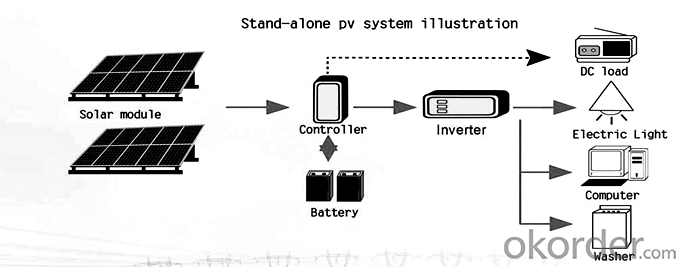
Data sheet
Maximum Power | 305W |
Efficiency | 0.157 |
Backsheet | Silver |
Frame Colar | White |
Manufacture Site | China |
Frame | Anodized Aluminum Alloy |
Weight | 27 kg |
FAQ:
Q1: Why buy Materials & Equipment from OKorder.com?
A: All products offered byOKorder.com are carefully selected from China's most reliable manufacturing enterprises. Through its ISO certifications, OKorder.com adheres to the highest standards and a commitment to supply chain safety and customer satisfaction.
Q2: What is a solar PV module?
A: A solar PV module consists of many solar cells that are connected together (typically in series) and packaged in a frame (typically made of aluminum).
Q3: What are the advantages and disadvantages of monocrystalline solar PV modules?
A: Monocrystalline solar PV modules are the most efficient type of solar PV modules, with the exception of CdTe thin film solar PV modules. As a result, monocrystalline solar PV modules are more expensive when compared to almost all other types of solar PV modules.
- Q: How do solar panels affect the resale value of a property?
- Solar panels can have a positive impact on the resale value of a property. Studies have shown that homes equipped with solar panels tend to sell for higher prices and at a faster rate compared to similar homes without solar panels. This is mainly due to the potential energy cost savings associated with solar power, as well as the increasing demand for renewable energy sources. Additionally, solar panels are seen as a valuable and sustainable investment, which can make a property more desirable to potential buyers.
- Q: Can solar panels be installed on a shipping container?
- Yes, solar panels can be installed on a shipping container. In fact, shipping containers offer a suitable platform for solar panel installation due to their large surface area and structural stability. This allows for efficient utilization of space and easy integration of solar panels into various applications, such as off-grid power systems or mobile energy solutions.
- Q: Can solar panels be installed on a university campus or educational facility?
- Yes, solar panels can certainly be installed on a university campus or educational facility. In fact, many institutions have already embraced solar energy as a sustainable and cost-effective solution. Solar panels can be installed on rooftops, parking structures, or open fields to generate clean electricity and reduce the carbon footprint of the campus. This not only helps in meeting sustainability goals but also provides an educational opportunity for students to learn about renewable energy and its environmental benefits.
- Q: Can solar panels be installed on a flat roof?
- Yes, solar panels can be installed on a flat roof. In fact, flat roofs are often considered ideal for solar panel installations due to their easy accessibility and potential for optimal sun exposure. Additionally, there are various mounting systems available that can be used to securely attach solar panels to flat roofs.
- Q: Can solar panels be used for charging batteries?
- Yes, solar panels can be used for charging batteries. Solar panels convert sunlight into electricity, which can be stored in batteries for later use. This makes solar panels an effective and sustainable solution for charging batteries, especially in remote areas or during power outages.
- Q: What is the lifespan of solar panel batteries?
- The lifespan of solar panel batteries can vary depending on various factors such as the type and quality of the battery, usage patterns, and maintenance. On average, solar panel batteries generally last between 5 to 15 years. However, with proper care and regular maintenance, some high-quality batteries can last up to 20 years or more.
- Q: I have to show in a project (a model house) how Solar Panels work. In my model I want to show Solar Panels creating electricity to power a T.V but I need to show how the power gets from the Solar Panels to the T.V. A diagram would be really helpful. Please try and make this as simple as possible as I'm only 3, but try and be specific as well!
- solar panels are made of solar cells.Solar cells are mainly made of a semiconductor called silicon,when sunshine on it,solar energy is converted into electrical energy by photovoltaic.The energy knocks electrons loose, allowing them to flow freely.This flow of electrons is a current, this current, together with the cell's voltage (which is a result of its built-in electric field or fields), defines the power (or wattage) that the solar cell can produce.
- Q: Can solar panels be used in multi-story buildings?
- Yes, solar panels can be used in multi-story buildings. They can be installed on the rooftops or facades of these buildings to harness solar energy and generate electricity. Additionally, advancements in solar panel technology have made it possible to integrate them into building materials, such as windows or cladding, allowing for even more flexibility in their use in multi-story structures.
- Q: How efficient are the solar panels....?
- Commercial monocrystalline panels are typically 8% efficient but inverters can be 65% to 90% efficient and lead acid batteries are 50% efficient at charging and 92% efficient at discharging plus they self-discharge at 3% to 20% per month.
- Q: i trying to make a solar panel. right now i dont have money to go and buy a copper sheet. so can i make it out of aluminum foil. if there is a way please tell me how. and what do i use for wires. i making this to charge batteries.
- You can't make a solar panel to generate any reasonable amount of electricity from that. You need a semiconductor to start with, in order to have something that can generate free charge carriers(electrons and holes) from photons. Then you need a junction which can separate the charges. In principle you could make a Shottky Diode solar cell from copper if you could find a doped semiconductor to bond a sheet of it to the copper. To form a decent electric field there should be a significant difference in work functions between the copper and the semiconductor, this will generally require the semiconductor to be doped. On top of this you would need a transparent conductor (most used are things like ITO or other 'TCOs' - Transparent Conducting Oxides) to be the top electrode to inject replacement charges into the semiconductor to replace the effect of recombination current. In summary, it's difficult to DIY. You generally need complicated machinery to get decent crystal growth and/or doping.
Send your message to us
305W Polycrystalline Silicon Solar Panels with Battery
- Loading Port:
- Guangzhou
- Payment Terms:
- TT OR LC
- Min Order Qty:
- 200000 watt
- Supply Capability:
- 20000000 watt/month
OKorder Service Pledge
OKorder Financial Service
Similar products
Hot products
Hot Searches

